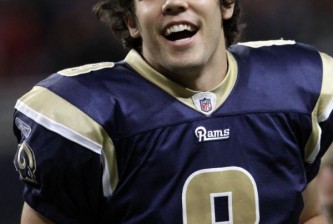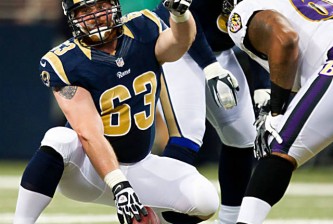Steve Spagnuolo approached his job as head coach of the Rams with a simple mantra: do the little things right, and the rest (i.e. winning) will take care of itself.
Unfortunately for him, he didn’t get the little things right. And the rest did not, in fact, take care of itself.
Bernie Miklasz wrote yesterday about the Rams and their culture of “Try,” which was the first and most important brick that Spagnuolo had to build his team with. He and Billy Devaney inherited a team that was full of dead weight — veteran players light on talent and lighter on effort. Guys who were physically or mentally battered to the point of uselessness.
Notable: Very few Rams from 2009’s cuts went on to be productive elsewhere, unlike more recent ex-Rams like Laurent Robinson and Daniel Fells.
Spagnuolo and Devaney succeeded in restocking the roster with players that had a coherent work ethic, a visible hunger. Some of these were blue-collar players, low on the talent scale, special teamers upjumped to starting jobs (think Danny Amendola and Craig Dahl). Others were pedigreed veteran players with a known work ethic (think Na’il Diggs and Jason Brown). And a precious few (Sam Bradford, Robert Quinn) were young foundation players with elite potential.
As far as little things go, getting the “Try” right is a big thing. A crucial foundation to everything else. But it’s far from the only thing. Failings in several other “little things” turned out to have a huge impact on the team’s regression.
Penalties
Spagnuolo was far too lenient on penalties with his team, often accepting “penalties of aggression” (i.e. pass interference, chop blocks, roughing the passer, etc.) as an inevitable by-product of trying hard. He would bemoan “penalties of concentration” (false starts, delays of game, personnel mistakes) after the fact, but showed little anger or resolve toward eradicating them.
Even after getting rid of lunkheads like Alex Barron and Richie Incognito, the Rams remained a magnet for yellow flags under Spagnuolo, a problem that was especially notable in the red zone. In fact, the problem got markedly worse, inexcusable for a coach who prides “attention to detail.”
| Year | Offensive Penalties | Defensive Penalties | Total |
|---|---|---|---|
| 2011 | 112 (8th) | 111 (8th) | 223 |
| 2010 | 102 (10th) | 126 (1st) | 228 |
| 2009 | 100 (10th) | 80 (28th) | 180 |
| 2008 | 97 (11th) | 89 (14th) | 186 |
Positioning
The Rams’ continuing woes in run defense are perhaps the clearest example of this, but Spagnuolo’s defenses were schematically more concerned with disruption than precision. Linemen, linebackers, and defensive backs liked to create motion, a now necessary part of the game as they try to disguise coverages and confuse the opposing quarterback. Confusing the opponent is good. Confusing yourself is bad.
Rams fans are well schooled to lay all the problems of our defense at our outside linebackers. Listen to any talk radio discussion of the defense, and that’s all you’ll hear. But according to Pro Football Focus, who grades every player on every play, our two worst run defenders in 2011 are two of our most aggressive players: DE Chris Long and S Darian Stewart.
Long has been unleashed as a pass-rushing force under Spags, and that’s a good thing. But his speed to the passer is predicated on slipping blocks, rushing upfield and taking looping cuts toward the pocket, creating vast holes to run underneath. This puts extra effort on the linebackers and safeties on his side of the field. And often, you could see Laurinaitis motioning his LBs to Long’s side of the line, and still wind up with a blocker on every Ram. St Louis was particularly vulnerable to pulling-guard run plays, which sent more linemen to Long’s side, forcing him wider and spreading the defense thinner.
Any amount of self-scouting would have pointed this out. But again, Spagnuolo was apparently willing to accept this as an inevitable by-product of his pass-rush scheme. Indeed, even as we churned through cornerbacks, our pass defense stayed pretty respectable thanks to that pressure. But that’s not good enough when you allow the run game to break you.
And overreaction to the run (i.e. bringing our safeties up into the box) created at least one busted deep coverage per quarter. While our defensive passing numbers are decent overall, the Rams gave up 12 plays of 40 yards or more, tied for fifth-most in the league. Would a full season of Ron Bartell and Bradley Fletcher have changed that? Undoubtedly, yes. But so would more disciplined safety play.
Game Management
I hardly need to hammer this one home. Fans have been howling at Spagnuolo’s lack of game feel since he arrived. And this is an area that I felt he had shown a little improvement on over time, in his ability to challenge his offense at key fourth-down opportunities.
But philosophically, whenever faced with a key momentum-changing moment in the game, Spags would nearly always prefer to trust his defense than to gamble with his offense. Perhaps he thought he had more ammunition on that side of the ball, and we could even say that he’s probably right about that. But ammunition runs out if you use it too much, and the Rams defense was nearly always on the field for too long.
We bemoan Spags’ lack of “go for the throat” mentality, but in his mind, going for the throat meant kicking a field goal from a safe distance, getting safe points, and then unleashing Chris Long and his dogs on the opposing passer. He lacked a command of his offensive toolkit, and lacked a sense of urgency that competing against the upper echelon of the NFL required.
If you watch the Packers, Lions, Patriots, or even Eli Manning’s Giants, you know that there are no such thing as safe points, no such thing as a safe lead. Even the Pittsburgh Steelers aren’t content to win games 9-6 or 10-7 any more.
The problem got worse with Josh McDaniels, as Spagnuolo delegated amost full responsibility for the offense to his assistant, and then watched helplessly as McD called for an endless array of long-developing routes and even longer-developing trick plays. McDaniels’ entire offensive philosophy was to go against the grain – run when the opponent is thinking pass, and vice versa. But the by-product of that included draw plays on 3rd ans 20, and shotgun sets on first and goal from the 1.
(As an aside, here’s an ignominious stat: The Rams led the NFL in incomplete passes this year. 257 times, a pass play ended with the ball on the ground, stopping the clock and digging a hole for the offense. Perhaps it’s no wonder Spagnuolo would sooner turn to his defense.)
Trying Wasn’t The Same As Competing
I’ve praised Steve Spagnuolo, the leader. So have many others who admire the man and what he stands for. He’s a smart, dedicated man who inspires passion among his players. I believe he will get another shot as head coach, and have a better chance of succeeding with the benefit of hindsight that his time here gave him.
But there is more to the NFL than effort. You need elite talent, and you need discipline to translate that talent into victories. You can blame Devaney (and his predecessors) for the lack of talent, but you have to lay blame for the lack of discipline squarely at Spags’ feet.
Ironically, it was a collection of little things that spelled Spagnuolo’s doom with the Rams.























